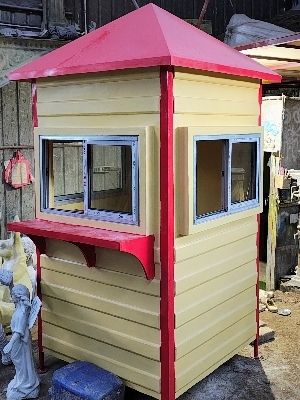Call us now
Security Cabin
45000 INR/Piece
Product Details:
- Feature Water Resistance, Durable, Easy To Clean, Easy To Install, Eco-Friendly, Washable
- Theme Decoration
- Regional Style Indian
- Surface Texture Smooth
- Usage & Applications Industrial
- Product Type Decoration
- Weather Resistance Indoor, Outdoor, Water-Resistant
- Click to View more
X
Security Cabin Price And Quantity
- 1 Piece
- 45000 INR/Piece
Security Cabin Product Specifications
- Multicolour
- Decoration
- Indian
- Standard
- Industrial
- Smooth
- Square
- 96 inch
- Handmade
- Water Resistance, Durable, Easy To Clean, Easy To Install, Eco-Friendly, Washable
- Painting
- Professional
- Resin, Metal
- Iron
- 95 kg
- High Quality
- 48 inch
- Indoor, Outdoor, Water-Resistant
- 48 × 48 × 96 inch
- 48 inch
- Decoration
- Yes
Security Cabin Trade Information
- Cash in Advance (CID)
- 100 Piece Per Month
- 7 Days
- Sample costs shipping and taxes has to be paid by the buyer
- Asia
- All India
Product Description
An FRP (Fiberglass Reinforced Plastic) security room, also commonly known as an FRP security cabin, guard room, or watchman cabin, is a prefabricated, portable structure designed to provide a secure and comfortable workspace for security personnel. These units are widely used across various sectors due to their durability, ease of deployment, and low maintenance. Here's a detailed description of an FRP security room: Core Construction and Appearance: * Material: The primary construction material is Fiberglass Reinforced Plastic. This composite material consists of a polymer matrix (usually polyester resin) reinforced with fine glass fibers. This combination results in a material that is exceptionally strong, yet lightweight. * Modular or Panel Build: FRP security rooms are typically manufactured as modular units or assembled from prefabricated FRP panels. This allows for quick and efficient installation on-site. * Shape and Size: They come in a variety of standard sizes (e.g., 4x4 ft, 4x6 ft, 6x6 ft, 8x8 ft, often with heights around 7-8 feet) and shapes (most commonly rectangular or square). Custom sizes and designs are also readily available to meet specific client requirements. * Aesthetic: While primarily functional, FRP security rooms can be designed with a neat and professional appearance. They are available in various colors (common being grey, white, blue, or green) and can have a smooth, glossy, or sometimes textured finish. Some may feature decorative elements like sloping roofs or small canopies over windows/doors. Key Features and Components: * Walls: Constructed from FRP panels, often with an insulated core (like PUF - Polyurethane Foam) for thermal and sound insulation. This ensures a comfortable internal environment, protecting personnel from extreme heat in summer and cold in winter, and reducing external noise. * Flooring: Typically made of sturdy FRP sheets, sometimes with an anti-skid surface, or a base of MS (Mild Steel) structural frame with FRP or plywood flooring. * Roof: Can be flat, sloped, or slightly curved, designed to shed rainwater effectively. Often insulated. * Doors: Usually single or double leaf doors made of FRP or a combination of FRP and other materials like aluminum. They come with secure locking mechanisms. * Windows: Generally provided with aluminum powder-coated sliding windows, often with clear or tinted glass. These allow for good visibility of the surrounding area while providing protection. Some designs include a small "writing counter" or ledge both inside and outside the window. * Electrical Fittings: Most FRP security rooms come pre-fitted with basic electrical provisions, including: * Internal light fittings (LED lights are common). * Power sockets for charging devices or operating small equipment. * Switches and proper wiring, often concealed within the wall panels. * Ventilation: In addition to sliding windows, some cabins may include small vents or provisions for exhaust fans to ensure proper airflow. * Optional Features: Depending on the client's needs, additional features can include: * Air conditioning units. * Internal counters or desks for record-keeping. * Storage shelves. * Integrated CCTV mounting points. * Washroom facilities (for larger units). * Branding or company logos on the exterior. Advantages of FRP Security Rooms: * Durability and Longevity: FRP is highly resistant to corrosion, rust, rot, and pests (like termites). It does not degrade under harsh weather conditions, including heavy rain, strong winds, and UV radiation, ensuring a long service life. * Lightweight and Portable: Compared to traditional brick-and-mortar structures, FRP cabins are significantly lighter, making them easy to transport, relocate, and install quickly on various terrains without extensive foundation work. * Weather Resistance and Insulation: Excellent thermal insulation properties help maintain a comfortable interior temperature, reducing the need for excessive heating or cooling. They are also waterproof and can withstand extreme temperatures. * Low Maintenance: FRP surfaces are smooth and non-porous, making them easy to clean with just soap and water. They do not require painting, sealing, or frequent repairs. * Security: Despite being lightweight, FRP panels are robust and offer good resistance to impact, providing a secure enclosure for personnel. Reinforced doors and windows further enhance security. * Customization: FRP allows for flexible design and customization in terms of size, layout, color, and additional features to suit specific security requirements and aesthetic preferences. * Cost-Effectiveness: While initial costs vary, the long lifespan, low maintenance, and quick installation time contribute to overall cost savings compared to conventional construction. * Eco-Friendly: In some aspects, FRP can be considered eco-friendly due to its long life, reducing waste from frequent replacements. Typical Usage/Applications: * Construction Sites: As temporary guard posts for site security. * Industrial Facilities: At entry/exit points, checkpoints, or within large complexes for patrolling guards. * Residential Complexes & Gated Communities: At main gates for security guards and visitor management. * Commercial Establishments: At office buildings, shopping malls, parking lots, and event venues. * Public Spaces: Parks, bus stops, railway stations, and fairgrounds. * Events: For temporary security needs at concerts, festivals, or exhibitions. In essence, an FRP security room is a modern, efficient, and reliable solution for creating dedicated, protected spaces for security personnel, offering a blend of practical utility and structural integrity.Tell us about your requirement

Price:
Quantity
Select Unit
- 50
- 100
- 200
- 250
- 500
- 1000+
Additional detail
Mobile number
Email




 Send Inquiry
Send Inquiry Send SMS
Send SMS